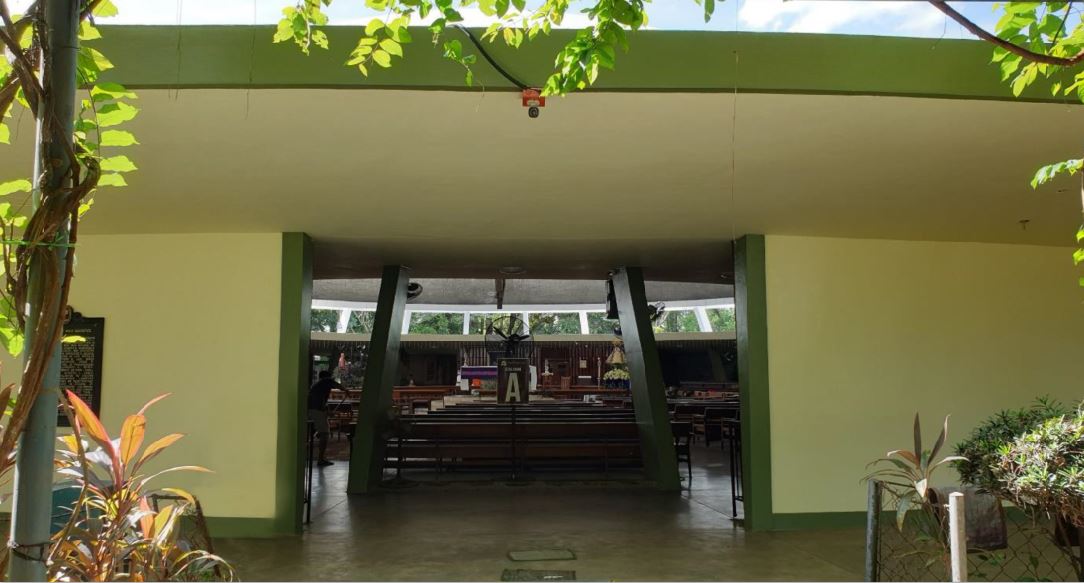I
have pleasant memories of this Chapel. The first mass and completion of
this chapel was on December 20, 1955. That day was my 21st birthday. It
was also the year of my appointment as Assistant Instructor in
Chemistry, College of Liberal Arts(at that time). For more detail On my
personal involvement with this Chapel, Fr Delaney and UPSCA visit the
site at the bottom of this page.
The following write up is from Goodnewsphilippines.com. It was published in FB and here is my comment.
The University of the Philippines Chapel, also known as the Parish Church of the Holy Sacrifice in Diliman, Quezon City, has received initial restoration work to repaint its interior and exterior facades and repair its worn-out parts.
The 65-year-old circular structure with the unique dome is a national historical landmark and cultural treasure completed on December 20, 1955. Designed by national artist for architecture Leandro Locsin and built by Engr. David M. Consunji, the founder of DMCI group of companies, the chapel underwent initial restoration from July 2020 to December 2020.
After a series of consultations with UP officials and the UP Parish, DMCI Homes led a team that facilitated the repair of masonry cracks, de-clogging of downspouts and drains, and the installation of new electrical fixtures. Repainting work was performed on the chapel’s iconic dome and roof as well as its walls, columns, eaves, under slabs, ceilings, and railings.
The murals depicting the Stations of the Cross, the marble altar, the floor mural, and the cross at the center of the chapel – all handiworks of national artists – were left untouched during the rehabilitation.
In 2021, DMCI is scheduled to next restore the chapel’s ceiling or the underside of the dome.

The UP Chapel is considered an important architectural landmark due to its unique and timeless design as it is the first circular chapel in the country with the altar in its center for a more personal and engaging community worship experience. It is also the first structure in the country to feature a remarkable thin-shell concrete dome, made possible through Engr. Consunji’s innovation in the mixing and delivery of concrete.
It is the only structure in the country to feature the works of five national artists:
- Arturo Luz designed the floor mural, titled the “River of Life”, executed in terazzo and radiating from the altar
- Napoleon Abueva created the giant wooden double-sided crucifix and the altar base
- Vicente Manansala and Ang Kiukok painted the 15 murals of the Stations of the Cross
- Leandro Locsin designed the chapel structure
These five men—Locsin, Luz, Abueva, Manansala, and Kiukok—were later on named National Artists of the Philippines, making the UP Chapel the only structure in the country to feature the works of five National Artists. With its unique and timeless architectural design, the UP Chapel has been recognized as a National Historical Landmark by the National Historical Commission of the Philippines, and a Cultural Treasure by the National Museum of the Philippines.
More Historical Notes on the UP Chapel
The UP Chapel had its beginnings in 1954 when Fr. John Patrick Delaney, S.J., who was the UP chaplain during the transfer of the University’s campus from Manila to Diliman in 1949, saw the need for a more permanent structure to replace the sawali-bamboo building that until then had been serving as the house of worship for the Catholics in the UP community.
Fr. Delaney came up with the concept for the UP Church and commissioned young, up-and-coming UP artists, engineers, and an architect to build the structure. Architect Leandro Locsin designed the church according to Fr. Delaney’s vision of a Church centered on the Holy Sacrifice of the Mass, with the priest close to his parishioners in a spirit of oneness and communion—a Church whose doors would always be open to anyone seeking to talk to God.
Engr. Alfredo Juinio, who served as the structural engineer for the project, and Engr. David Consunji, founder of the DMCI Group of Companies, constructed it as the country’s first circular, concentrically arranged chapel with the altar at its center. It is also the first to have a thin shell concrete dome, supported by pillars located at the sides of the church; so there are no supports to block the space inside. The thin shell-dome was made possible through Engr. Consunji’s innovation in the mixing and delivery of concrete.
Churches around the Philippines have been undergoing restoration work in preparation for the 500th anniversary of the arrival of the Christian faith in the islands, including the San Agustin Church in Intramuros and the Barasoain Church in Bulacan.
Related Post:
The wedding cake Decor of our wedding-1:1000 miniature of the UP Chapel, May 8, 1957
https://theintellectualmigrant.blogspot.com/2016/12/remembering-up-chapel-of-holy-sacrifice.html


No comments:
Post a Comment